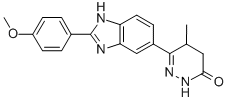| Identification |
| Name: | 3(2H)-Pyridazinone,4,5-dihydro-6-[2-(4-methoxyphenyl)-1H-benzimidazol-6-yl]-5-methyl- |
| Synonyms: | Acardi;Racemic pimobendan;UD-CG 115;UD-CG 115BS;Vetmedin;3(2H)-Pyridazinone,4,5-dihydro-6-[2-(4-methoxyphenyl)-1H-benzimidazol-5-yl]-5-methyl- (9CI); |
| CAS: | 74150-27-9 |
| Molecular Formula: | C19H18N4O2 |
| Molecular Weight: | 334.37 |
| InChI: | InChI=1/C19H18N4O2/c1-11-9-17(24)22-23-18(11)13-5-8-15-16(10-13)21-19(20-15)12-3-6-14(25-2)7-4-12/h3-8,10-11H,9H2,1-2H3,(H,20,21)(H,22,24) |
| Molecular Structure: |
 |
| Properties |
| Density: | 1.36 |
| Refractive index: | 1.692 |
| Specification: |
?Pimobendan , its cas register number is 74150-27-9. It also can be called Pimobendane ; dl-Pimobendan ; and 4,5-Dihydro-6-[2-(4-methoxyphenyl)-1H-benzimidazol-5-yl]-5-methyl-3(2H)-pyridazinone . It is a positive inotrope, and?sensitizes and increases the binding efficiency of cardiac myofibril to the calcium ions that are already present without increasing the consumption of oxygen and energy. It is metabolized into its active form by the liver, and?is absorbed rapidly when given via the oral route and has a bioavailability of 60-65%.
|
| Safety Data |
| |
 |